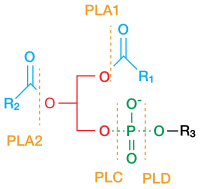Phospholipase A 2
| Phospholipase A 2 | ||
|---|---|---|
| Mass / length primary structure | approx. 120 amino acids | |
| Cofactor | Calcium | |
| Identifier | ||
| Gene name (s) | PLA2G1B , PLA2G2A , PLA2G2D , PLA2G2E , PLA2G2F , PLA2G3 , PLA2G4A , PLA2G4B , PLA2G4C , PLA2G4D , PLA2G4E , PLA2G4F , PLA2G5 , PLA2G6 , PLA2G10 , PLA2G12A | |
| Enzyme classification | ||
| EC, category | 3.1.1.4 , phospholipase | |
| Response type | hydrolysis | |
| Substrate | Phosphatidylcholines + H 2 O | |
| Products | 1-acylglycerolphosphocholine + carboxylate | |
| Occurrence | ||
| Parent taxon | Eukaryotes , proteobacteria | |
Phospholipase A 2 (correct: phosphatidylcholine-2-acylhydrase , PLA 2 for short ) are called enzymes that split fatty acids from the C2 atom of phosphoglycerides . They are therefore indispensable for eukaryotes in the breakdown of these substances, but also as an initial reaction in the biosynthesis of prostaglandins . In addition, the poisons of snakes , monitor lizards , insects , crown of thorns sea stars and some molluscs contain these enzymes. Mammals have at least four types of PLA2; humans have 16 isoforms. Mutations in PLA2G6 - gene can for rare hereditary neurodegeneration with brain iron accumulation and Karak syndrome lead.
classification
The PLA 2 is divided into secreted and cytosolic phospholipases A 2 according to localization .
The secreted PLA 2 are mainly found in amniotes , 19 are known from arthropods and two from cnidaries . Almost all known PLA 2 from reptiles occur as adder and viper-like , three in crustaceans . All PLA 2 from reptiles and arthropods are secreted by the venom gland and act as a toxin and allergen . The release of PLA 2 into the blood plasma in higher mammals can take place for several reasons, the most important of which is signal transduction in the inflammatory reaction . Some isoforms can be localized in the cell membrane after secretion.
The cytosolic PLA 2 have so far only been found in quadrupeds and zebrafish , and still in plants and proteobacteria .
In humans, different isoforms of PLA 2 can not only be localized in different cell types , but also be specific for different substrates. Human PLA 2 are:
- secreted: PLA2G1B, PLA2G2A, PLA2G2D, PLA2G2E, PLA2G2F, PLA2G3, PLA2G5, PLA2G10, PLA2G12A
- cytosolic: PLA2G4A, PLA2G4B, PLA2G4C, PLA2G4D, PLA2G4E, PLA2G4F, PLA2G6, PLA2G12A
Catalyzed reaction
The enzyme from the family of esterases catalyzes the hydrolytic cleavage of phospholipids on the second carbon - atom (β-carbon atom). It comes u. a. for the release of arachidonic acid from membrane lipids .
The phospholipase A 2 can be prepared by glucocorticoids can be inhibited, the synthesis of eicosanoids limits and thus anti-inflammatory (anti-inflammatory) effect.
Significance for the occurrence of coronary heart disease
In a study published in May 2010, the authors investigated in 79,036 patients to what extent the phospholipase A 2 level was linked to the risk of developing coronary artery disease , stroke or death. A clear correlation was shown, which placed increased phospholipase A 2 levels in the blood on a par with the risk levels of high blood pressure or high LDL cholesterol levels in the blood.
See also
Individual evidence
- ↑ UniProt O60733
- ↑ Search result at UniProt, sorted by taxon
- ↑ Coronary artery disease: markers of inflammation as responsible as high blood pressure and LDL cholesterol. Announcement in The Lancet of April 30, 2010.
- ^ The Lp-PLA2 Studies Collaboration. Lipoprotein-associated phospholipase A2 and risk of coronary disease, stroke, and mortality: collaborative analysis of 32 prospective studies. Lancet 2010; 375: 1536. doi : 10.1016 / S0140-6736 (10) 60319-4 .
